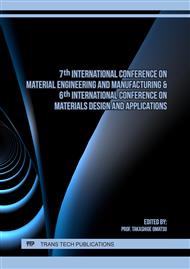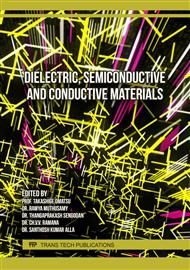[1]
B. E. Murdock, K. E. Toghill and N. Tapia-Ruiz: A Perspective on the Sustainability of Cathode Materials used in Lithium-Ion Batteries, Advanced Energy Materials, Vol. 1, No. 39, 2102028, 2021.
DOI: 10.1002/aenm.202102028
Google Scholar
[2]
D. Chung, E. Elgqvist, and S. Santhanagopalan: Automotive Lithium-ion Cell Manufacturing: Regional Cost Structures and Supply Chain Considerations, Clean Energy Manufacturing Analysis Center (CEMAC), 2016.
DOI: 10.2172/1247459
Google Scholar
[3]
M. Malik, K. H. Chan, and G. Azimi: Review on the synthesis of LiNixMnyCo1-x-yO2 (NMC) cathodes for lithium-ion batteries, Materials Today Energy, Vol. 28, 101066, 2022.
DOI: 10.1016/j.mtener.2022.101066
Google Scholar
[4]
Thailand Automotive Institute: Spent Battery Management Business Report, 2018.
Google Scholar
[5]
M. Chen, X. Ma, B. Chen, R. Arsenault, P. Karlson, N. Simon, and Y. Wang: Recycling End-of-Life Electric Vehicle Lithium-Ion Batteries, Joule, Vol. 3, No. 11, 2019, p.2622–2646.
DOI: 10.1016/j.joule.2019.09.014
Google Scholar
[6]
P. Liu, L. Xiao, Y. Tang, Y. Chen, L. Ye and Y. Zhu: Study on the reduction roasting of spent LiNixCoyMnzO2 lithium-ion battery cathode materials, Thermal Analysis and Calorimetry, Vol. 147, No. 24, 2018, pp.1323-1332.
DOI: 10.1007/s10973-018-7732-7
Google Scholar
[7]
D. L. Thompson, J. M. Hartley, S. M. Lambert, M. Shiref, G. D. J. Harper, E. Kendrick, P. Anderson, K. S. Ryder, L. Gaines and A. P. Abbott: The importance of design in lithium ion battery recycling - a critical review, Green Chemistry, Vol. 22, pp.7585-7603, 2020.
DOI: 10.1039/d0gc02745f
Google Scholar
[8]
D. A. Ferreira, L. M. Zimmer Prados, D. B. Majuste and M. B. Mansur: Hydrometallurgical separation of aluminium, cobalt, copper and lithium from spent Li-ion batteries, Power Sources, Vol. 187, No. 1, 2009 pp.238-246.
DOI: 10.1016/j.jpowsour.2008.10.077
Google Scholar
[9]
N. Vieceli, R. Casasola, G. Lombardo, B. Ebin, and M. Petranikova: Hydrometallurgical recycling of EV lithium-ion batteries: Effects of incineration on the leaching efficiency of metals using sulfuric acid, Waste Management, Vol. 125, 2021, pp.192-203.
DOI: 10.1016/j.wasman.2021.02.039
Google Scholar
[10]
C. Peng, F. Liu, Z. Wang, B. P. Wilson and M. Lundström: Selective extraction of lithium (Li) and preparation of battery grade lithium, Power Sources, Vol. 415, 2019, pp.179-188.
DOI: 10.1016/j.jpowsour.2019.01.072
Google Scholar
[11]
X. Chen, Y. Chen, T. Zhou, D. Liu, H. Hu and S. Fan: Hydrometallurgical recovery of metal values from sulfuric acid leaching liquor of spent lithium-ion batteries, Waste Management, Vol. 38, 2015, pp.349-356.
DOI: 10.1016/j.wasman.2014.12.023
Google Scholar
[12]
W. S. Chen and H. J. Ho: Recovery of Valuable Metals from Lithium-Ion Batteries NMC Cathode Waste Materials by Hydrometallurgical Methods, Metals, Vol. 8, No. 5, 321, 2018.
DOI: 10.3390/met8050321
Google Scholar
[13]
Q. Li, K. Yip Fung, and K. M. Ng: Separation of Ni, Co, and Mn from spent LiNi0.5Mn0.3Co0.2O2 Cathode Materials by Ammonia Dissolution, ACS Sustainable Chemistry&Engineering, Vol. 7, No. 15, 2019, pp.12718-12725
DOI: 10.1021/acssuschemeng.9b00590
Google Scholar
[14]
J. Kumar, X. Shen, B. Li, H. Liu, and J. Zhao: Selective recovery of Li and FePO4 from spent LiFePO4 cathode scraps, Waste Management, Vol. 113, 2020, pp.32-40.
DOI: 10.1016/j.wasman.2020.05.046
Google Scholar
[15]
J. Li and Z.-Feng Ma: Past and Present of LiFePO4: From Fundamental Research to Industrial Applications, Chem, Vol. 5, No. 1, 2019, pp.3-6.
Google Scholar
[16]
D. J. Shin, S. H. Joo, D. Lee and S. M. Shin: Precipitation of lithium phosphate from lithium solution by using sodium phosphate, The Canadian Journal of Chemical Engineering, Vol. 100, No. 12, 2021, pp.1-8.
DOI: 10.1002/cjce.24368
Google Scholar
[17]
M. P. Do, J. J. Roy, B. Cao and M. Srinivasan: Green closed-loop cathode regeneration from spent NMC-based lithium-ion batteries through bioleaching, ACS Sustainable Chem. Eng., Vol. 10, No. 8, 2022, pp.2634-2644.
DOI: 10.1021/acssuschemeng.1c06885
Google Scholar
[18]
S. Tao, J. Li, L. Wang, L. Hu and H. Zhou: A method for recovering Li3PO4 from spent lithium iron phosphate, Ionics, Vol. 25, 2019, pp.5643-5653.
DOI: 10.1007/s11581-019-03070-w
Google Scholar



